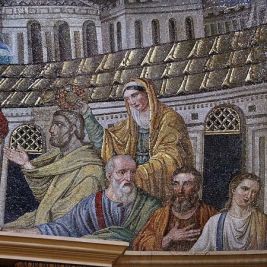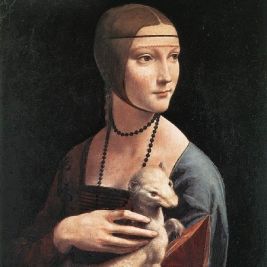
Romanticism style in interior design is characterized by classical elegance, softened with colors and lace
The Romanticism style in interior design is a traditional design direction that is close to the classical style but with a softer and cozier atmosphere that promotes relaxation. Romanticism style is chosen by refined and creative individuals who prioritize emotions over practicality and a rational approach to life. They add light curtains, ruffles on pillows and bedspreads, floral ornaments on the walls, and live bouquets to the strict classical elements such as arches and moldings.
 Romanticism style in interior design. Romantic bedroom interiors
Romanticism style in interior design. Romantic bedroom interiors
The Romanticism style in interior design can resonate and be combined with other classic and rustic themes such as Provence, retro, Victorian, English, and Tuscan styles, to some extent with Gothic. A home in the Romanticism style is filled with an atmosphere of tranquility and serenity. It is the perfect place to escape from the everyday hustle and bustle.
 Romanticism style in interior design. Romantic living room interior
Romanticism style in interior design. Romantic living room interior
Main characteristics and features of the Romanticism style in interior design
The Romanticism style in interior design is often referred to as feminine, as it is characterized by curved lines, floral patterns, warm pastel tones, and shiny accents of gold and silver. To make the space more masculine, pink blossoms can be replaced with neutral stripes, and silk and lace can be substituted with wool and velvet. The pastel delicacy can be complemented with furniture made of dark wood. The main features of the Romanticism style in interior design are as follows:
- Color palette. Soft neutral shades serve as the basis, with lighter tones more commonly used than earthy tones. The most popular colors include muted white, dusty pink, peach, lavender, and blue. Very dark and vibrant colors, as well as sharp contrasts, are not used.
- Lighting. Romantic interiors are associated with large windows, and they feature natural light softened by thin curtains. In the evening, a soft semi-darkness can be maintained to promote relaxation. Candles and fabric lampshades fit perfectly into such an environment, as do ornate chandeliers with crystal pendants.
- Materials and finishes. Like any traditional style, Romanticism embraces natural materials such as hardwood or parquet flooring, ceramics, and marble. Plaster is used for ceilings, including plaster moldings, while walls can be adorned with floral or geometric patterned wallpaper, tiles, or wooden panels.
- Furniture. When this style first emerged, furniture pieces were custom-made, and each one was unique. For such an ambiance, classic-style items with softly curved edges and original designs are needed. Wrought-iron beds, vintage dressers, and large trunks can be used.
- Textiles. This is an important component of the Romantic style. It typically involves the use of various fabrics, such as lace, silk, satin, and velvet. Canopies and bedspreads with floral patterns or solid colors are placed on beds, while chair covers feature waves and bows, and pillows are adorned with embroidery and ruffles.
- Accessories. Paintings, mirrors in ornate frames, and black-and-white photographs are hung on the walls. Other suitable decorations include beautiful boxes, porcelain, and live flowers. Souvenirs brought from travels and items reminiscent of distant lands, such as a compass, globe, or seashell, are also welcomed.
 Romanticism style in interior design. Romanticism floral bedroom interior
Romanticism style in interior design. Romanticism floral bedroom interior
 Romanticism style in interior design. Romanticism canopy bedroom interior
Romanticism style in interior design. Romanticism canopy bedroom interior
The history of the Romanticism style in interior design
Romanticism emerged at the intersection of the 18th and 19th centuries in Germany. Initially, it manifested itself in poetry but quickly extended beyond literature and permeated other forms of art. Later on, it also began to appear in everyday spheres such as fashion and interior design. This movement arose as a counteraction to strict classicism, whose ideals were reason and duty. In contrast, Romanticism proclaimed entirely different values: freedom, genuine emotions, and closeness to nature. The history of Romanticism style in interior design was interrupted only in the first half of the 20th century due to wars and a general decline in living standards.
 Romanticism style in interior design. Romanticism style room interior with vintage furniture
Romanticism style in interior design. Romanticism style room interior with vintage furniture
Just a few years after World War II, ultra-feminine images inspired by past eras emerged, first in the collections of Christian Dior and then in private interiors. This trend appeared slightly earlier in the United States but soon spread across Europe as well. Since then, and up to the present day, Romanticism remains popular. Photographs of homes and apartments designed in this style are regularly featured in thematic magazines.
 Romanticism style in interior design. Romantic interior of a terrace
Romanticism style in interior design. Romantic interior of a terrace
The Romanticism style demands taste and a sense of harmony from the designer. It's important not to overdo the details, as delicate tenderness can turn into unnatural sweetness. However, if done correctly, the interior becomes an embodiment of beauty, softness, and comfort. Such an ambiance appeals to every lover of the exquisite.
 Romanticism style in interior design. Romanticism style bedroom interior with a wrought iron bed
Romanticism style in interior design. Romanticism style bedroom interior with a wrought iron bed
 Mosaic - the art of creating a complete picture from many small individual pieces
Mosaic - the art of creating a complete picture from many small individual pieces  The top 10 most famous Italian artists - the greatest masters of painting in Italy of all time
The top 10 most famous Italian artists - the greatest masters of painting in Italy of all time  Golden Age of Dutch painting - an era that gave the world the finest masterpieces of Dutch art of all times
Golden Age of Dutch painting - an era that gave the world the finest masterpieces of Dutch art of all times  Pablo Picasso was a recognized genius of 20th-century art
Pablo Picasso was a recognized genius of 20th-century art  Illustration is a colorful and visually appealing drawing that complements the content of a book
Illustration is a colorful and visually appealing drawing that complements the content of a book  Salvador Dali - a brilliant surrealist artist
Salvador Dali - a brilliant surrealist artist  Sculpture "The Pietà" by Michelangelo Buonarroti is a iconic work in Catholicism
Sculpture "The Pietà" by Michelangelo Buonarroti is a iconic work in Catholicism  Bartolomeo Francesco Rastrelli was a brilliant Italian architect who became the greatest master of Russian architectural art of all times
Bartolomeo Francesco Rastrelli was a brilliant Italian architect who became the greatest master of Russian architectural art of all times  The Order of St. Patrick is the most prestigious Irish distinction
The Order of St. Patrick is the most prestigious Irish distinction  Surrealism is art from the depths of the human subconscious
Surrealism is art from the depths of the human subconscious